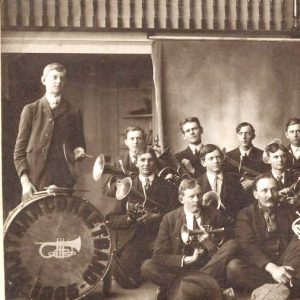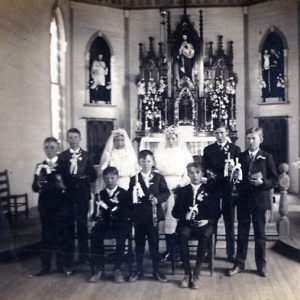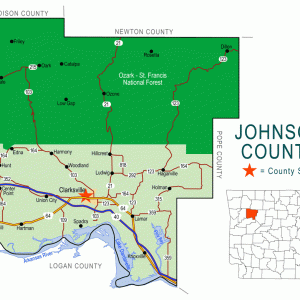calsfoundation@cals.org
Hartman (Johnson County)
| Latitude and Longitude: | 35º25’57″N 093º36’56″W |
| Elevation: | 390 feet |
| Area: | 1.58 square miles (2020 Census) |
| Population: | 516 (2020 Census) |
| Incorporation Date: | October 13, 1911 |
Historical Population as per the U.S. Census:
|
1810 |
1820 |
1830 |
1840 |
1850 |
1860 |
1870 |
1880 |
1890 |
1900 |
|
– |
– |
– |
– |
– |
– |
– |
– |
– |
– |
|
1910 |
1920 |
1930 |
1940 |
1950 |
1960 |
1970 |
1980 |
1990 |
2000 |
|
– |
– |
542 |
561 |
418 |
299 |
400 |
517 |
498 |
596 |
|
2010 |
2020 | ||||||||
|
519 |
516 |
The first owner of the land on which Hartman was built was Oren Davis Hogins, who purchased several tracts of Johnson County land beginning in 1837. Other settlers also bought land in the area and established farms that grew cotton and various fruits and vegetables, as well as raising livestock. When the Civil War began, many of the men from the area enlisted with the Confederate army, serving in Company H of the Twenty-sixth Arkansas Infantry and in Company C of the First Arkansas Mounted Rifles. The area was devastated by bushwhackers during the war and was slow to recover.
A settlement was already growing in 1874 as the Little Rock and Fort Smith Railroad began construction of a line connecting Clarksville to Fort Smith (Sebastian County). This line later became part of the Iron Mountain Railroad. Mary Hogins, a prominent landowner, called the settlement Coalburg. A railroad conductor remembered only as T. Hartman promised to have a depot and sidetrack built at the settlement if the residents would name the city for him. They obliged, and he kept his promise.
Beginning in 1880, Roman Catholic immigrants from Germany began arriving in Hartman. Some were farmers, but others established stores and other businesses in the young city. The Sacred Heart Church of Hartman was established in 1882. It was joined by a Baptist church in 1893 and a Methodist church in 1908. A one-room schoolhouse was also built shortly after the arrival of the first settlers. It was replaced by a two-story schoolhouse with three classrooms, which in turn was replaced in 1926 by a brick schoolhouse with six classrooms. Hartman was noted for a cornet band that performed at various gatherings in the area, including a prohibitionist rally at which Carrie Nation spoke in 1905. The Bank of Spadra was relocated and renamed the Bank of Hartman in 1910.
By 1921, Hartman was being described as “one of the most prosperous towns in the state.” In addition the bank, school, and churches, the city also had several stores, two livery stables, two hotels, a restaurant, two blacksmith shops, a tinshop, telephone facilities, three doctors, and “one regular cow-buyer,” according to local historian Ella Molly Langford. Many residents were involved in the coal industry. Troubled times began for the city with a fire in November 1926 that destroyed many downtown buildings. The Flood of 1927 caused more devastating damage both to the city and to nearby coal mines. The school district remained viable, with rural districts consolidated into the Hartman school district. The Depression, coupled with an increase in mechanized farming, further reduced work opportunities in the following years. The population continued to decline during and after World War II. By the 1950s, downtown Hartman had only two stores, a Masonic lodge, a post office, and a barbershop. Railroad passenger and mail service to Hartman ended on March 21, 1960. By this time, the automobile traffic that used to transverse the city on Highway 64 had been rerouted onto Interstate 40, bypassing the city. Undoubtedly, that change hastened the decline of the city.
Agriculture in the area revived in the late twentieth century with the growth of vineyards in western Arkansas. The children of Hartman attend schools in the Westside School District in Johnson County. The population of Hartman in 2010 was 519, nearly all of whom were white.
For additional information:
Langford, Ella Molloy. History of Johnson County, Arkansas: The First Hundred Years. Clarksville, AR: Johnson County Historical Society, 1976, 1981.
Logan, S. H. “Early Days of Hartman.” Johnson County Historical Society Journal 30 (Spring 2003): 15–17.
Stewart, David R. “A Brief History of Hartman.” Johnson County Historical Society Journal 2 (June 1976): 85–98.
Steven Teske
Butler Center for Arkansas Studies
 Hartman Band
Hartman Band  Hartman Catholic Church
Hartman Catholic Church  Johnson County Map
Johnson County Map 



Comments
No comments on this entry yet.